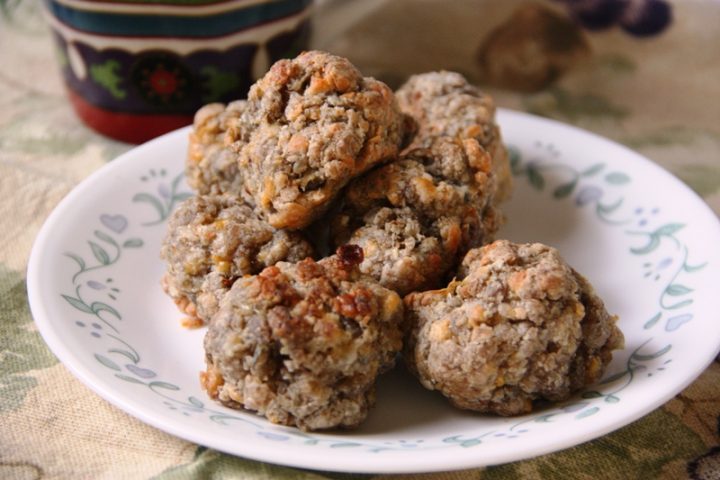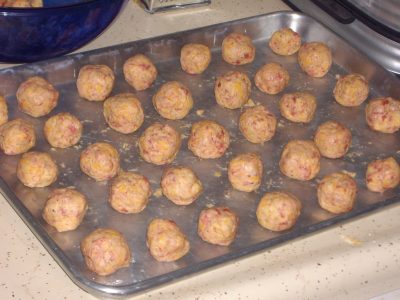
We were so proud of the cheese ball we made that Christmas Eve afternoon. I blended gorgonzola, cheddar and cream cheese, folded in spiced-rum-soaked raisins, added dashes of nutmeg, ground cloves, too, and then rolled the whole thing in chopped pecans my boyfriend had toasted on the wood stove.
Full of patting each other on the back as we slathered cracker after cracker with what was surely the most envious cheese ball in all of eastern North Carolina, the two of us decided we should text a photo to the finest cook among our best kayaking buddies.
Supporter Spotlight
Beaming at the ding of his reply, certain it was a lip-smacking emoji, we grabbed the phone only to be deflated. A photo and its caption clearly indicated our defeat.
“Sausage balls ?”
When it comes to holiday nibbles in North Carolina, nothing beats these mini-meatball morsels of pork and cheddar cheese. Experiencing a Christmas without sausage balls is like waking up to no presents under the tree.
Throughout December, sausage balls show up on just about every coastal Carolina party table. Hundreds of them stacked on a regal silver tray or packed tightly in plastic containers send the message: “Eat your fill.”
Most people do.
Supporter Spotlight
Proper Preparation
Each sausage ball is everything – salty, spicy, savory, succulent. That is, if you prepare sausage balls correctly, which only sounds easy. The basic sausage ball recipe calls for three ingredients: sausage, cheddar cheese and Bisquick baking mix. Perfect sausage balls, however, require practice and finesse.
Achieving bold, irresistible flavor and spot-on crisp-to-tender ratio means choosing a zesty but not overly spiced sausage and sharp but not too dry cheddar. As for Bisquick, add a measure that merely binds the sausage and cheese.
Why Bisquick? Sometime after Minnesota-based General Mills introduced the baking mix in 1931, the company created a sausage balls recipe as one of many ways to use the convenience product. Sausage balls went on to become one of the most requested recipes, General Mills reported at its Betty Crocker website.
You could, of course, forgo the partially-hydrogenated-oil-laced baking mix in favor of a homemade mix of flour, leavening, salt and fat. Sausage balls appear to have started closer to that method back in medieval Winchester, where monks in the late 1400s ate morterells. Cinnamon and chopped onions seasoned a half-and-half combination of sausage and bread crumbs that was shaped into small balls, simmered gently and then fried in lard until golden brown.
Although more elaborate than today’s sausage balls, morterells were considered humble, daily fare, likely a way to stretch meat supplies.
Cinnamon sounds like an interesting twist on the Bisquick recipe. Some people add chopped pecans or chopped jalapenos to sausage balls. Better Crocker continually updates the recipe according to changing tastes. The latest version calls for minced rosemary. Another suggests shredded apples. Milk is recommended to help keep sausage balls moist.
I once made sausage balls with Italian sausage and provolone cheese, and although they were yummy, I don’t recommend the recipe. Nor do I advise homemade biscuit mix. North Carolinians don’t like sausage balls to stray from the simple original.

Tar Heels may tinker with the amount of Bisquick and cheese they use. Some like a moister texture and add less Bisquick. Cheese lovers add more cheddar. That’s about as far as they’ll wander. Fiddle too much with the three-ingredient formula and you might as well put Santa Claus in a purple suit.
When rolling sausage balls, “the most important thing is to make it the perfect size. It has to fit in your mouth in one bite,” Fayetteville Technical Community College chef and culinary instructor Nadia Minniti said.
Minniti suggests each sausage ball be 1½ inches in diameter, about the size of a walnut. Try using a spring-loaded mini scoop to insure each sausage ball rolls out to the same size.
Sausage balls must bake exactly long enough that their bottoms become barely crunchy while the inside remains moist and tender. Temperature recommendations vary from 350 to 400 degrees. The hotter the oven, the higher risk of dry sausage balls, which aren’t so bad. Sausage balls are sort of like pizza in my opinion. I’ve never eaten one I didn’t like.
Betty Crocker recipe developers suggest adding ½ cup of milk to this recipe to ensure moist sausage balls. Choose sausage with a little bite. Many North Carolinians prefer the Greensboro-based Neese’s brand, which sells its original country sausage recipe, spicy “hot” sausage and one with extra sage. Sausage balls may be rolled, frozen and baked straight from the freezer. You may also bake, freeze and then reheat. They’re delicious served warm or at room temperature. Some people load cooked sausage balls in a crock pot, cover them in barbecue sauce and serve them warm straight from the pot, Minniti said.
Sausage Balls
3 cups Original Bisquick mix
1 pound uncooked bulk pork sausage
4 cups shredded cheddar cheese (16 ounces)
Heat oven to 350 degrees. Lightly grease bottom and sides of jelly roll pan, 15½-by-10½ inches in size.
In large bowl, stir together Bisquick, sausage and cheese using your hands or a heavy spoon. A stand mixer works well, too, but mix lightly to avoid a dense texture. Shape mixture into 1-inch balls. Place in pan.
Bake 20 to 25 minutes or until brown. Immediately remove from pan. Serve warm or at room temperature.
Makes about 100 sausage balls.
Cheddar Apple Sausage Balls
1 pound bulk pork sausage with sage
2½ cups shredded sharp cheddar cheese (10 ounces)
2 cups Original Bisquick baking mix
1 Braeburn apple, peeled and shredded (about 2 cups of shredded apple)
Paprika, if desired
Heat oven to 400 degrees. Line cookie sheets with cooking parchment paper.
In large bowl, mix sausage, cheese, baking mix and apple with hands until well blended. Shape mixture into 1½-inch balls; place 1 inch apart on cookie sheets.
Bake 12 to 14 minutes or until golden brown and no longer pink. Sprinkle lightly with paprika. Serve warm.
Makes about 40 sausage balls.
Source: All recipes from bettycrocker.com







